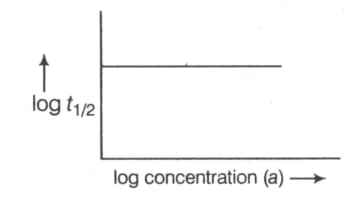MEDIUM
Earn 100
It is true that :
(1) A zero order reaction is a single step reaction.
(2) A second order reaction is always a multistep reaction.
(3) A first order reaction is always a single step reaction.
(4) A zero order reaction is a multistep reaction.
(a)Statement 1 is correct
(b)Statement 2 is correct
(c)Statement 3 is correct
(d)Statement 4 is correct
50% studentsanswered this correctly
Important Questions on Chemical Kinetics
EASY
The units for the rate constant and the rate of reaction are same for a reaction. What will be the order of the reaction?
EASY
One gram of () decays by -emission to in years. The half-life period of the reaction is
EASY
A first order reaction takes minutes for completion. Calculate the half life of reaction.
HARD
What will be the order of the reaction for hydrolysis of methyl acetate with by using the data provided?
Time
Volume of acid
EASY
For the elementary reaction , the rate of disappearance of increases by a factor of upon doubling the concentration of . The order of the reaction with respect to is
EASY
Hydrolysis of ester is a first order reaction. For this reaction, the correct statement is
HARD
Gaseous cyclobutene isomerizes to butadiene in a first order process which has a '' value of at The time in minutes it takes for the isomerization to proceed to completion at this temperature is_____. (Rounded off to the nearest integer)
MEDIUM
Half-life period for a first order reaction is minutes. How much time is required to change the concentration of the reactants to ?
EASY
The reaction is of the first-order. If the volume of the reaction vessel is reduced to the rate of the reaction would be
MEDIUM
For the chemical reaction
, the reaction proceeds as follows
(Fast)
, (Slow)
the rate law expression should be given as
MEDIUM
The rate of a reaction is found to depend upon two concentration variables. What should be the order of the reaction?
HARD
In the reaction,
the time taken for reaction of is twice the time taken for reaction of . The concentration of varies with reaction time as shown in the figure.The overall order of the reaction is:

EASY
For a certain reaction between and the order with respect to is and that with respect to is If the concentrations of both and are tripled. the rate of reaction will increase by a factor of ________
EASY
It takes for a first order reaction to go to completion. The total time required for the same reaction to reach completion will be
MEDIUM
Graph plotted between versus log concentration is a straight line. What conclusion can you draw from the graph?

order of reaction
EASY
For a reaction
The proposed mechanism is as given below:
1. (slow)
2. (fast)
Write the overall order of a reaction.
HARD
For the following reaction the rate of reaction is . Two moles of are mixed with one mole of to make of solution. At mole of is left in the reaction mixture. The correct statement(s) about the reaction is(are) Use:
MEDIUM
The time required for completion of a first order reaction is . The time required for completion of the same reaction will be
MEDIUM
Decomposition of follows a first order reaction. In fifty minutes the concentration of decreases from to in one such decomposition. When the concentration of reaches , the rate of formation of will be:
MEDIUM
What is the correct difference between first and second order reactions?

